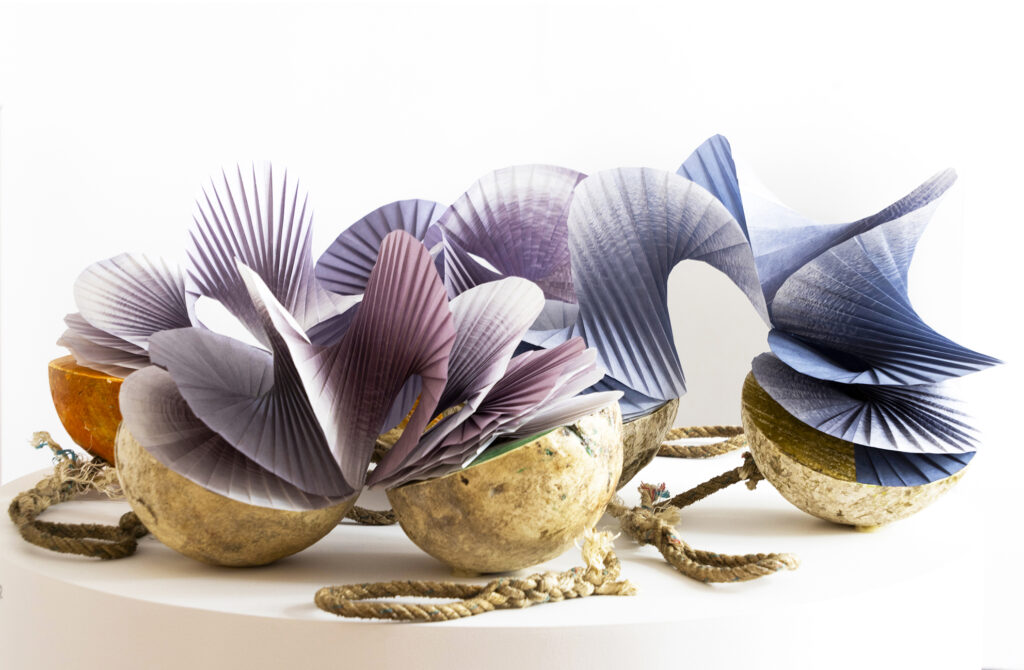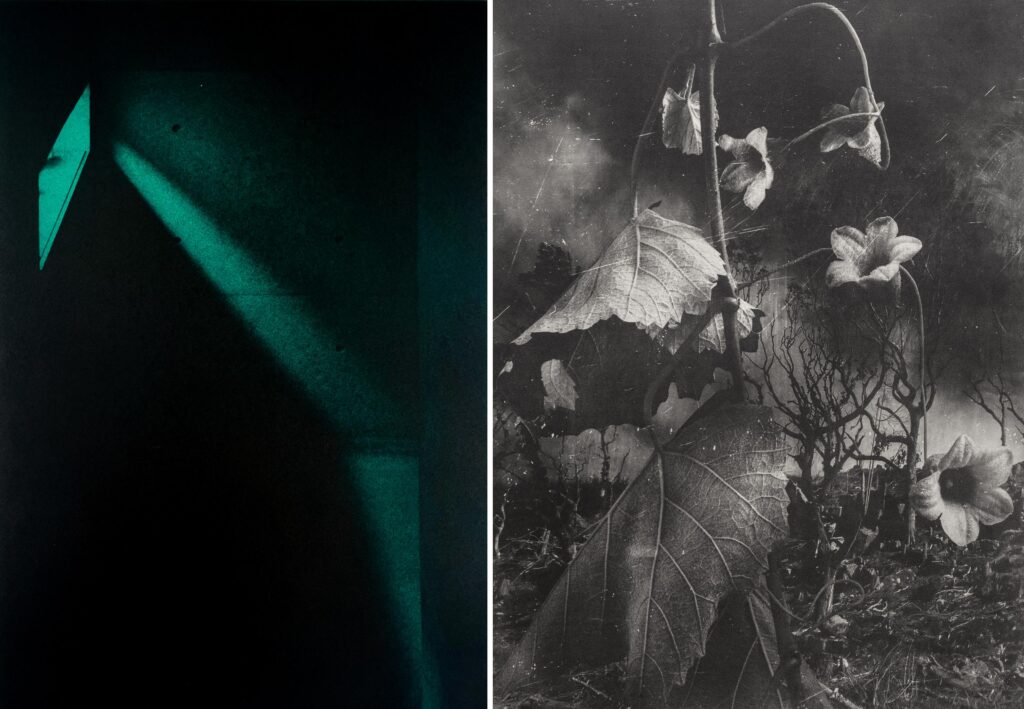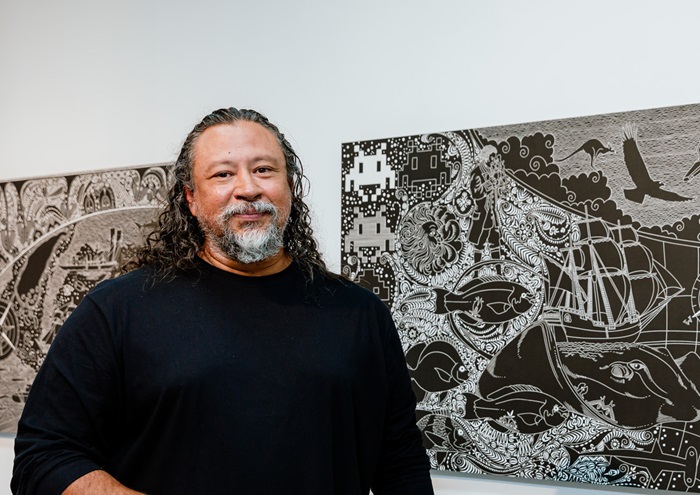Top:
Anne Langdon, Dreamscape [The Guardians Series], 2023, silkscreen, solar plate etching, 57 x 43 cm, unique state
Below:
Anne Langdon, Tulip Wave (detail) in process
Diana Orinda Burns, The White Shadow – Hermodastylus Tuberosus 1, 2023, monoprint with collaged chine-collé on Awagami Bunkoshi paper, 76 x 56 cm, unique state
Diana Orinda Burns, assembling The White Shadow of the Fleur-de-lis
Jackie Gorring, Taffy, 2024, relief print on paper plus fleece, 50 x 65cm, edition of 2
Jackie Gorring, Speedway Bohdi (detail)
Loris Button, Van Eyck’s Turban #6, 2024, linoprint, collage and hand colouring on BFK and hanji papers, 46 x 56 cm, unique state
Loris Button, drawing up the Van Eyck’s Turban block
Dianne Longley, House of Good Fortune, 2024, concertina artist book with hand-tinted intaglio prints, rubber stamp borders, book closed 21.5 x 17.5 x 2 cm, book open 21.5 x 306 cm, four unique books – #2
Dianne Longley, hand colouring the pages
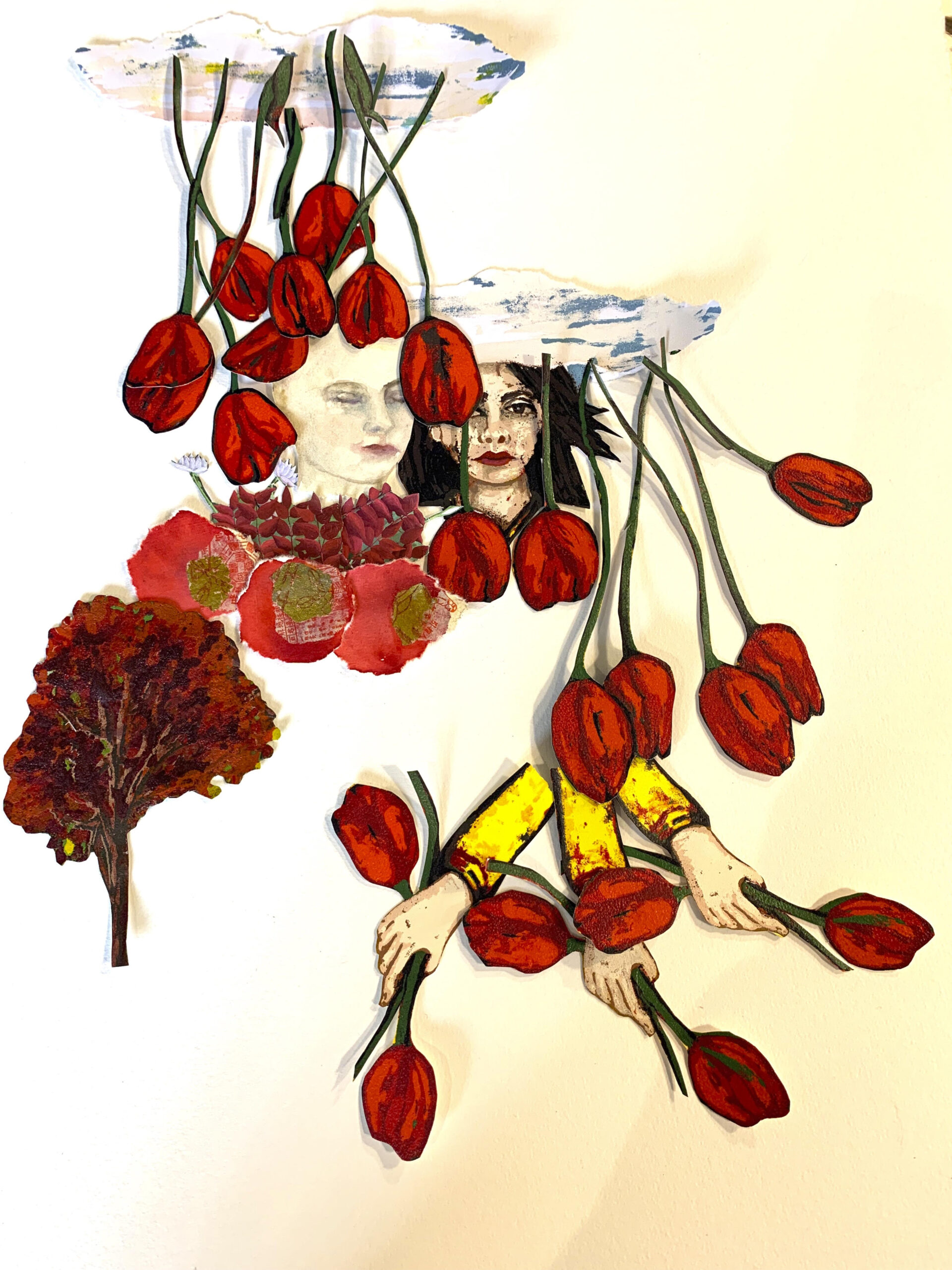
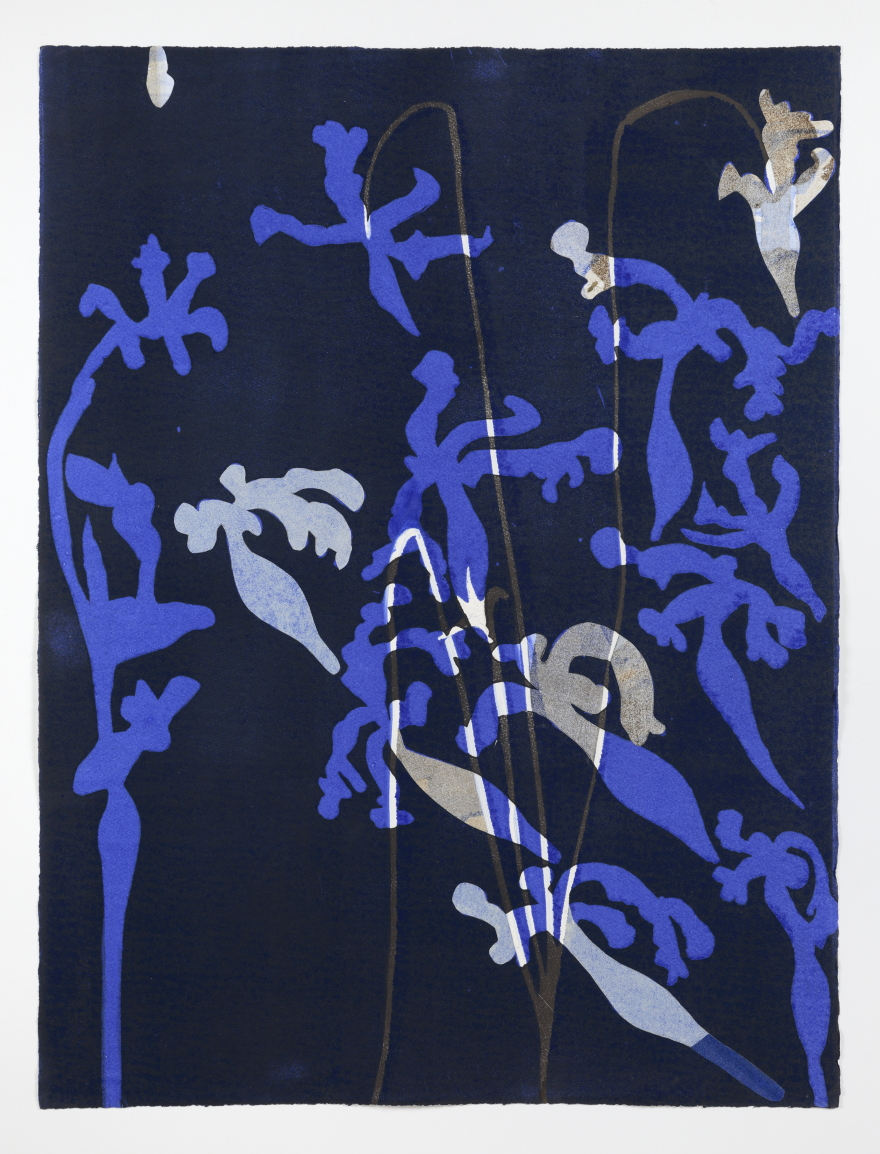
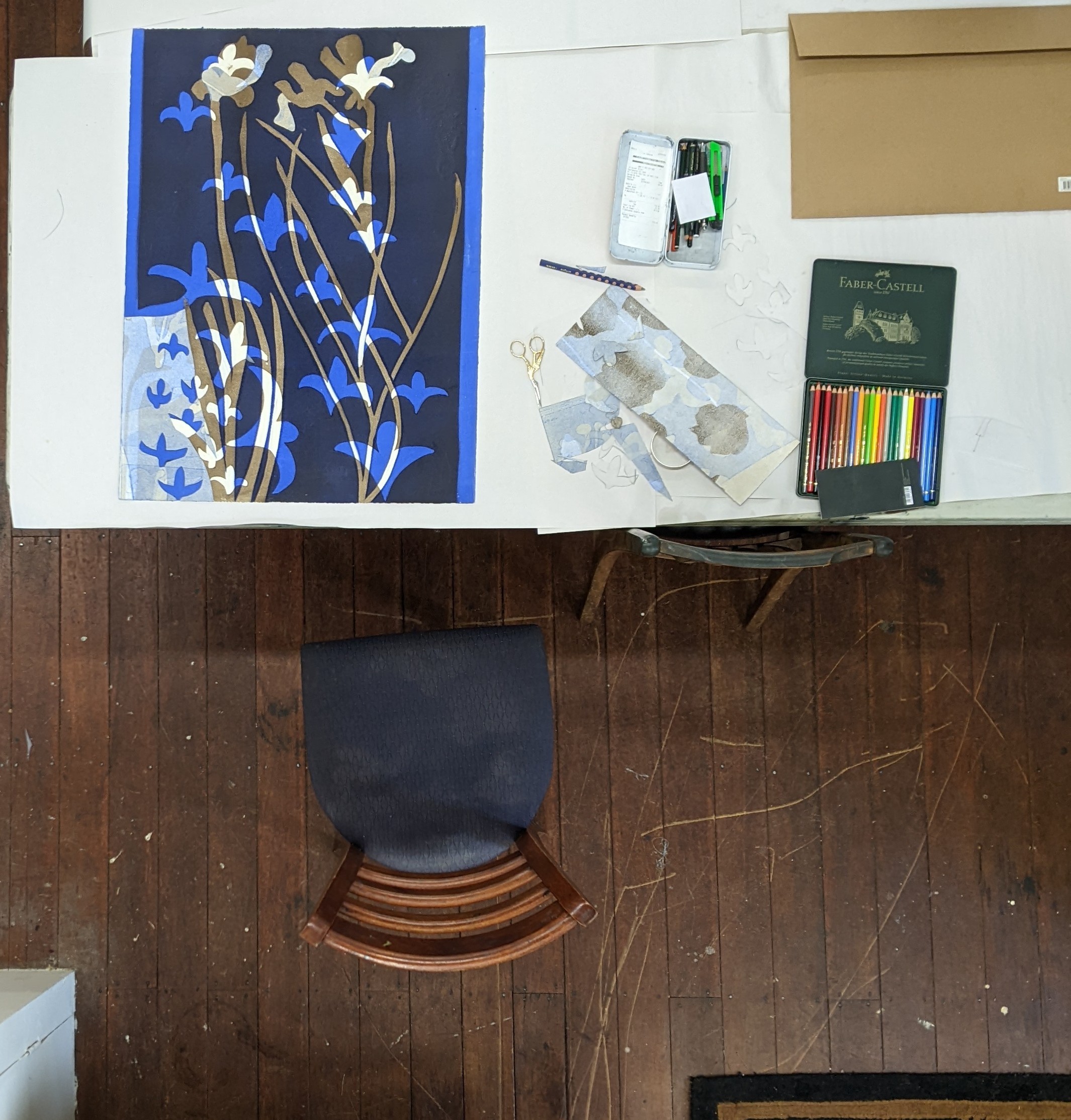
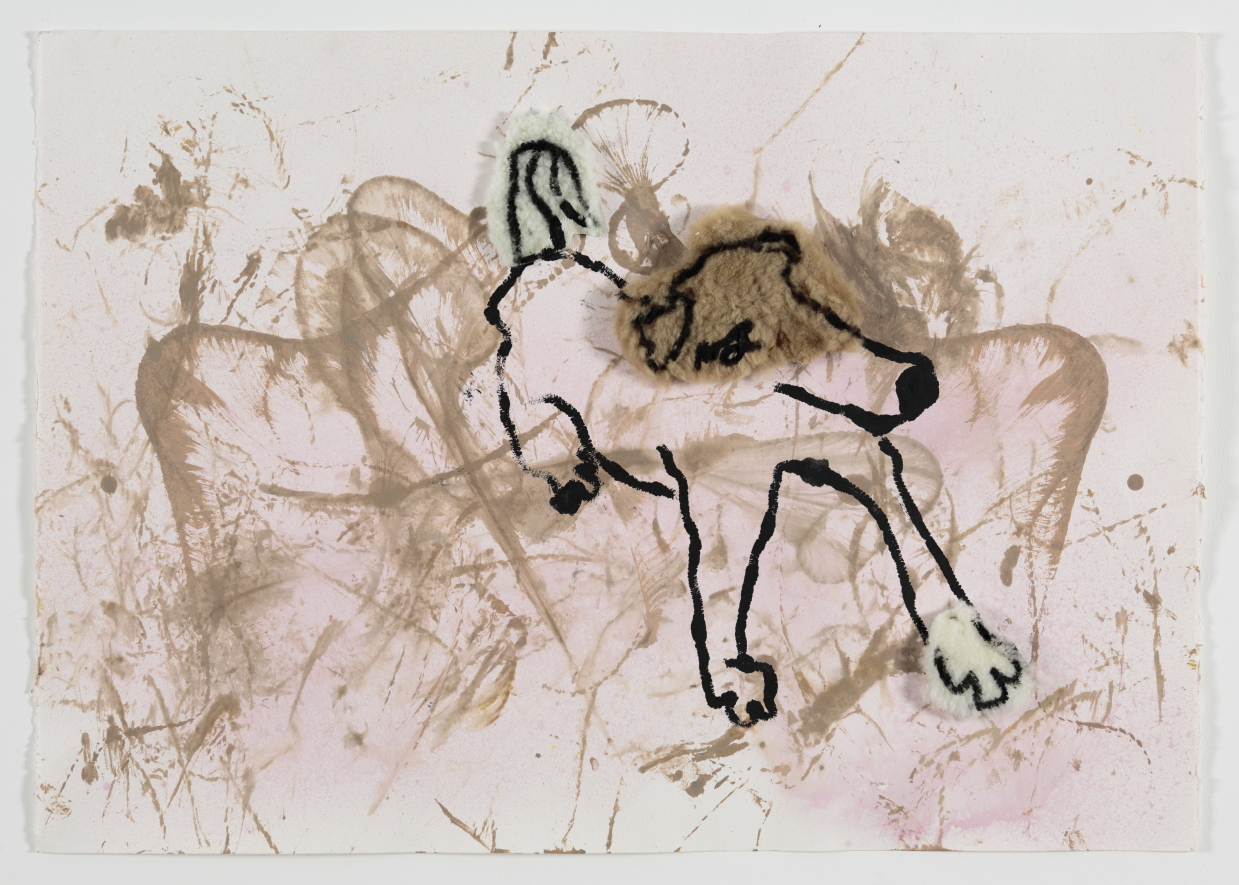
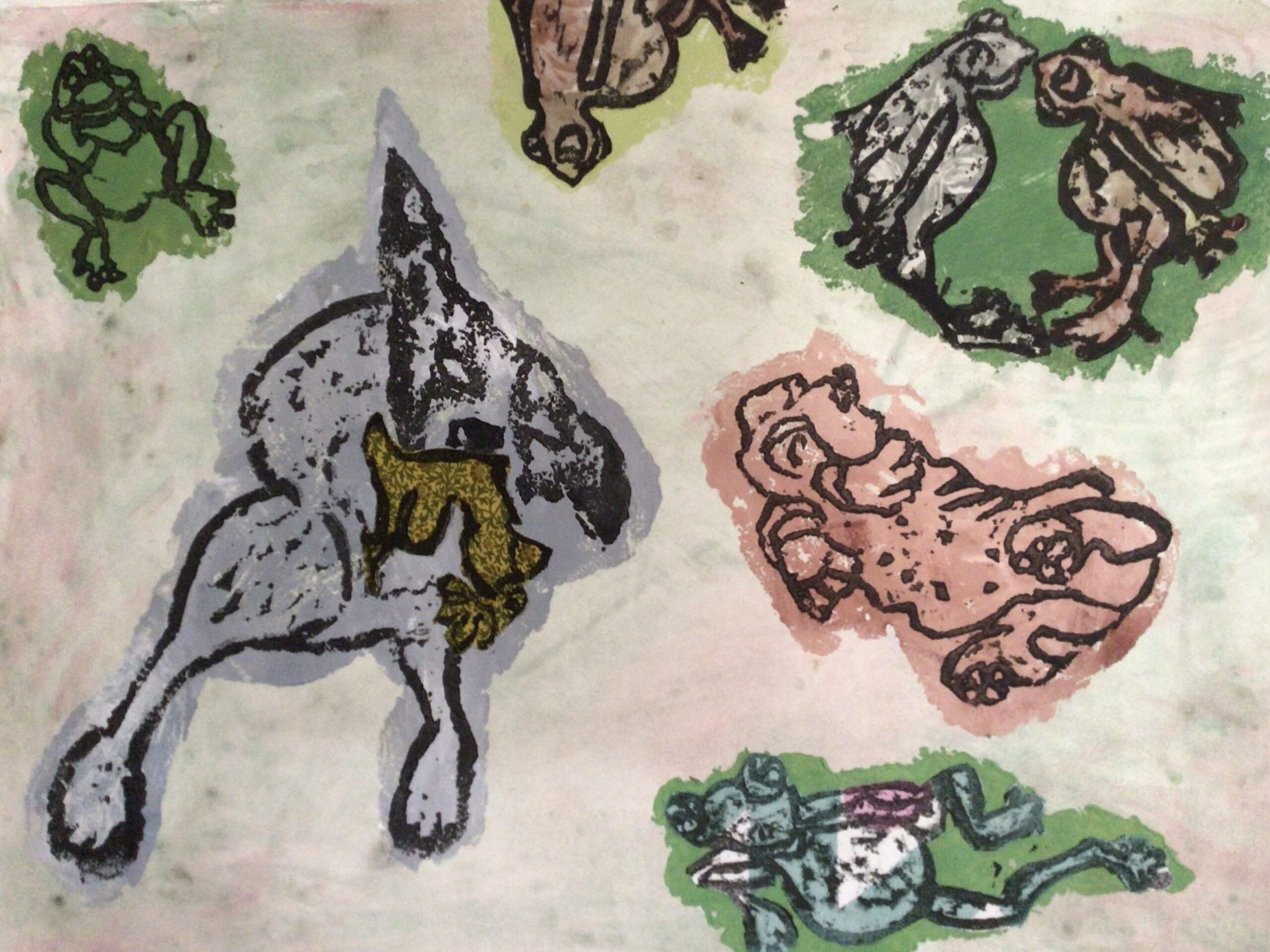
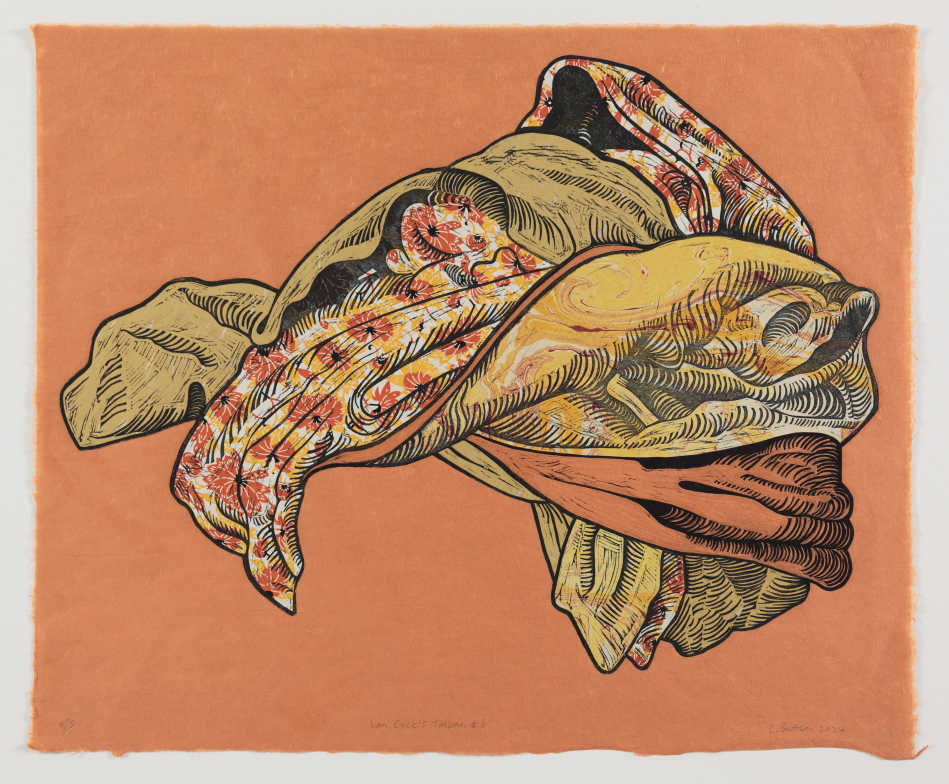
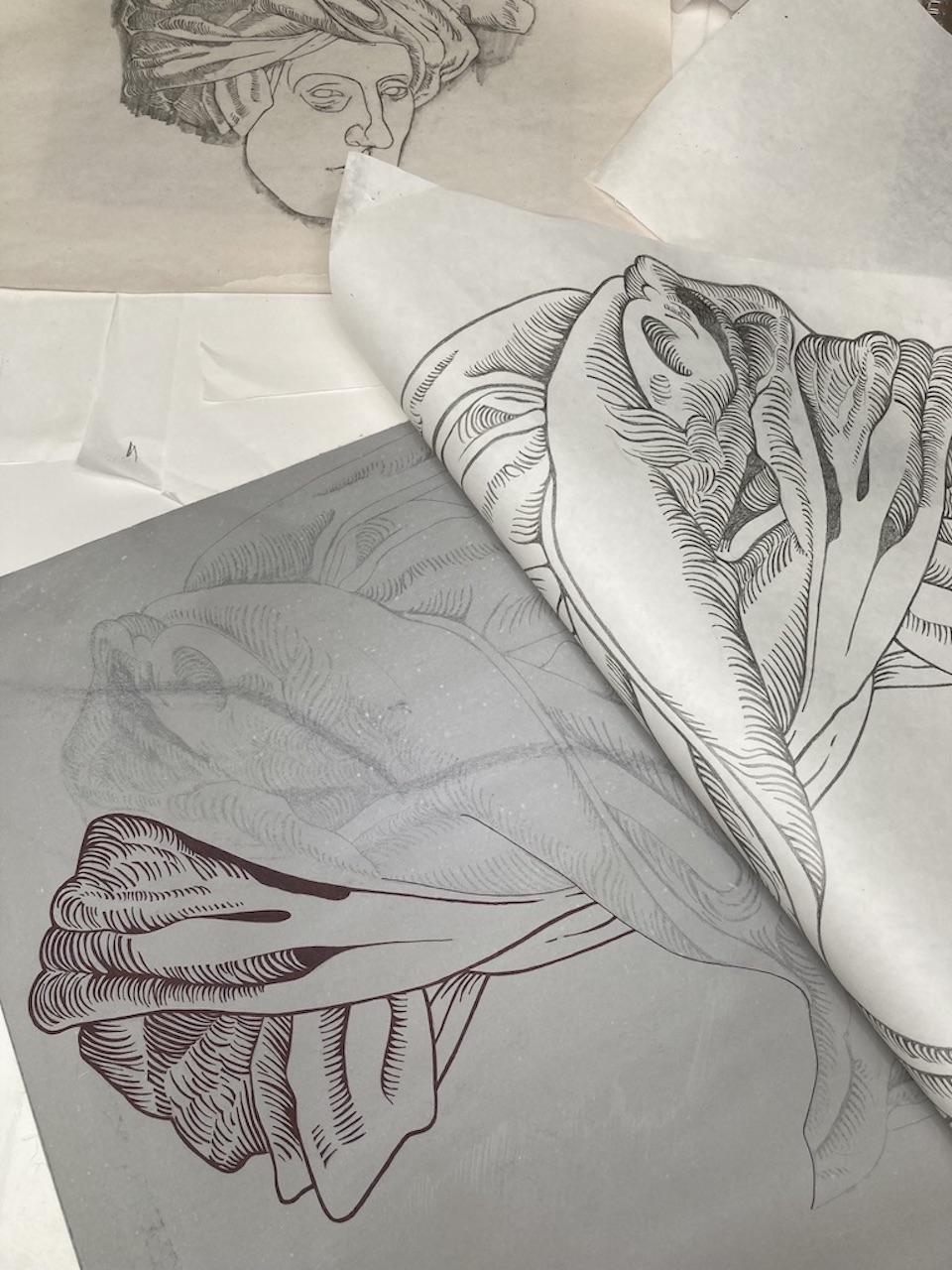
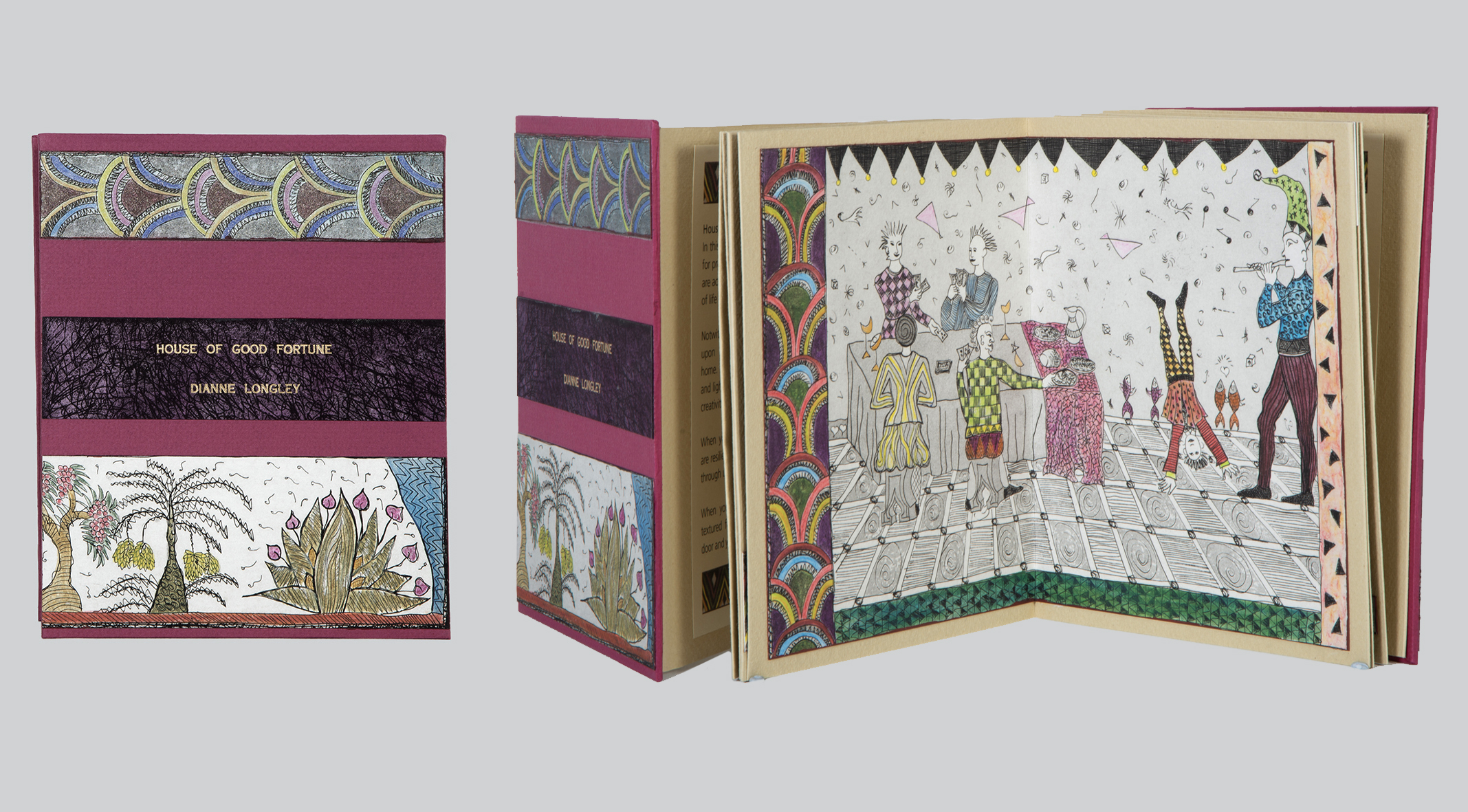
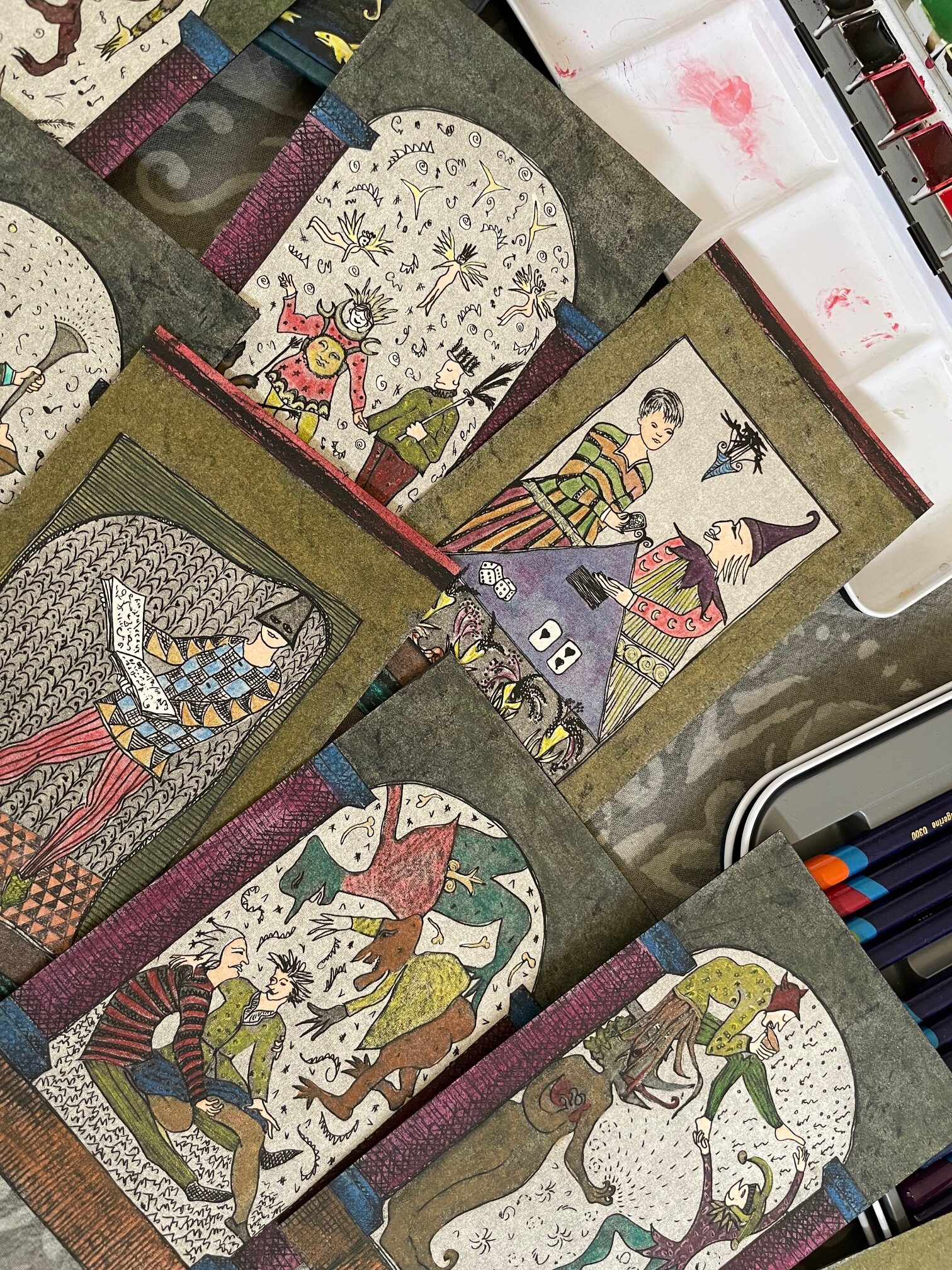
Collage from the French verb coller, meaning ‘to glue’, is the artistic process of gluing and assembling various materials to a flat surface. Found imagery forms the basis of the collage techniques employed by many artists, but for this small group of printmakers, collage provides an endlessly inventive way to play with their own printed imagery – and printmaking in turn, with paper as its most usual, but not exclusive substrate – is ideally suited to the pursuit of cutting and pasting.
Seeing this exhibition as an ideal opportunity to play with the multiple means at our disposal to perform collage, all of us have created new work for STUCK.
Anne Langdon uses the print form by reconstructing and reworking her prints. She incorporates painting, drawing and stitching to provide a diversity of techniques when creating her collages. Langdon has had a long printmaking history, beginning with multiple-colour silkscreen prints, and then exploring etching, dry point, solar plates and linocuts. Recent exploration of reduction-colour linocuts and silkscreens using a method similar to ‘ternes burton’ registration, has provided a strong platform from which to develop ideas. That journey into printmaking along with a love of drawing and painting, has developed into a deep exploration of collage techniques. Boxes of ‘collageable’ bits litter her studio. Collage is intuitive, playful and fun and as it is all about personal decision making, it is a highly reflective practice wherein deconstructing and constructing images is like recomposing an idea.
Jackie Gorring works in relief print using mainly Styrofoam for her blocks. She cuts, gouges and pieces together Styrofoam in order to print onto paper, canvas and even palm fronds, developing combinations of chine collé with fabric or various coloured papers. In her printmaking practice she is concerned with the human condition – home and places she has been, people, flora and fauna, travels to Asia, Europe and within Australia. Text, as well – words overheard or seen as signage. Neighbours – bizarre habits, their animals and plants, comings and goings, all find their way into the work.
For Diana Orinda-Burns, rearranging by cutting and pasting shapes and colours to provide curious, resolved compositions with various papers and her own prints, provides the impetus for her collaged monoprints. The inspiration for the work in this exhibition may be found in the natural world. In her garden irises grow, their shapes complex and intriguing, the colours bold and beautiful, compelling in their structure, contradictory in their appearance of strength and fragility. The White Shadow series is an exploration of contemplation and endeavour, death and beauty, and a search for the profundity of stillness, an inquiry into the invisible power of beauty and creativity. Aesthetics plays an important part in these collaged prints, as does the idea that shadows are associated with the idea of the unseen or hidden aspects of ourselves and the world. The symbolism of the iris and the fleur-de-lis are interpreted through the colours of the golden browns of the earth and the ultramarine sky. These playful collage compositions explore the joy of the creative spirit.
A relative latecomer to printmaking after originally working in the fields of drawing and painting, Loris Button’s printed collages emerge from cutting skills acquired in a former working life in the graphic arts and publishing industries. These skills, together with a love of printed and handmade papers inform her approach to printmaking. Revisiting old blocks and making new ones in combination with collage and chine collé has become the focus of her work in recent years. The Van Eyck’s Turban series is based in part on the 1433 painting, Portrait of a Man by Jan van Eyck, in which he wears a magnificent red turban. One of her first linoprint images was based on that wonderful portrait, and she has since returned to it repeatedly to create new prints, drawings and paintings. In this instance, the face has been removed, leaving only the shape and form of the intricately wound cloth as the subject matter. This new body of work considers the diversity of outcomes available through a single linocut block – an exploration of form, colour, pattern and repetition is at the heart of this meditation on a single image – one that has drawn the artist back time and again over more than twenty years.
Dianne Longley’s artist books speak to the notion of destiny: chance events, random moments, intersections, accidental choices and considered decisions. Her fantastic worlds and mystical dreamscapes often combine primordial plant forms with fanciful figures and imagined landscapes. Inhabiting these liminal worlds are a cast of creatures and plants which are combined to create various peculiar and curious scenarios. Her characters live in a world where nothing is certain. Some of her works are playful and whimsical, others are more layered and speculative in intent. New work created for the STUCK exhibition takes the form of artist books created from black and white prints originally editioned in the late 1980s. Pavilion of Dreams and House of Good Fortune were created using a concertina book structure, with the original etchings cut and hand-tinted, and pasted or ‘stuck’ onto the accordion pages. Attention was paid to the back of the book with decorative elements pasted there too. The House of Good Fortune print was a PCA commission print in 1989.
Rather than being held together by subject matter or theme, for these five artists STUCK places a focus on the simple gluing process that connects our work, and the widely varying outcomes that occur as we all apply the same sticky techniques to our differing subject matter and imagery.
—
STUCK is at the Print Council of Australia Gallery, printcouncil.org.au, 18 June-5 July, opening reception Thursday 20 June 5-7pm.
—
Join the PCA and become a member. You’ll get the fine-art quarterly print magazine Imprint, free promotion of your exhibitions, discounts on art materials and a range of other exclusive benefits.

![1_ALangdon_Dreamscape [The Guardians series]2023](https://www.printcouncil.org.au/wp-content/uploads/2024/06/1_ALangdon_Dreamscape-The-Guardians-series2023.jpg)
